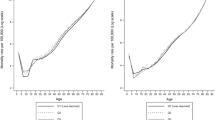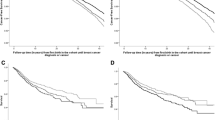Abstract
Objective
Cancer is among the leading causes of death in children, and the influence of socioeconomic inequalities on childhood cancer is an important public health concern. We examined the relationship of socioeconomic position with childhood cancer mortality in South Korea.
Methods
A retrospective cohort study of South Koreans was conducted using data from the national birth register collected between 1995 and 2006, which was individually linked to mortality data. A cohort of 6,479,406 children was followed from birth until their death or through December 31, 2006. Poisson regression analysis was used to estimate the rate ratios of childhood cancer death according to socioeconomic position.
Results
A total of 1,469 cancer deaths were observed during the study period. We found significantly increased cancer mortality to be associated with the educational level of mother (RR = 1.56, 95% CI 1.27–1.91) and father (RR = 1.39, 95% CI 1.15–1.70) in middle school graduate or below compared with those of college graduate or higher. The risks of cancer death increased among children born with fathers outside the workforce (RR = 1.36, 95% CI 1.09–1.69) and with mothers engaged in manual work (RR = 1.41, 95% CI 1.03–1.92), when compared with those of non-manual counterparts. Children born in rural areas showed significantly increased risk of death from cancer.
Conclusions
We concluded that in South Korea, there were inequalities in childhood cancer mortality by socioeconomic position.
Similar content being viewed by others
Abbreviations
- ICD:
-
International classification of diseases
- RR:
-
Rate ratio
- CIs:
-
Confidence intervals
- PIN:
-
Personal identification number
- SEP:
-
Socioeconomic position
- KNSO:
-
Korea national statistical office
References
American Cancer Society (2007) Global cancer facts and figures 2007. Available at: http://www.cancer.org/
Korea National Statistical Office (2007) Annual report on the cause of death statistics. Korea National Statistical Office, Daejeon
Macassa G, Ghilagaber G, Bernhardt E, Diderichsen F, Burstrom B (2003) Inequalities in child mortality in Mozambique: differentials by parental socio-economic position. Soc Sci Med 57:2255–2264
Oliveira ZA, Bettiol H, Gutierrez MR, Silva AA, Barbieri MA (2007) Factors associated with infant and adolescent mortality. Braz J Med Biol Res 40:1245–1255
Shaw C, Blakely T, Crampton P, Atkinson J (2005) The contribution of causes of death to socioeconomic inequalities in child mortality: New Zealand 1981–1999. N Z Med J 118:U1779
Singh GK, Kogan MD (2007) Widening socioeconomic disparities in US childhood mortality, 1969–2000. Am J Public Health 97:1658–1665
Blakely T, Atkinson J, Kiro C, Blaiklock A, D’Souza A (2003) Child mortality, socioeconomic position, and one-parent families: independent associations and variation by age and cause of death. Int J Epidemiol 32:410–418
Nelson MD Jr (1992) Socioeconomic status and childhood mortality in North Carolina. Am J Public Health 82:1131–1133
Ostberg V (1992) Social class differences in child mortality, Sweden 1981–1986. J Epidemiol Community Health 46:480–484
Vågerö D, Ostberg V (1989) Mortality among children and young persons in Sweden in relation to childhood socioeconomic group. J Epidemiol Community Health 43:280–284
Khang YH, Lynch JW, Yun S, Lee SI (2004) Trends in socioeconomic health inequalities in Korea: use of mortality and morbidity measures. J Epidemiol Community Health 58:308–314
Son M, Oh J, Choi YJ, Kong JO, Choi J, Jin E et al (2006) The effects of the parents’ social class on infant and child death among 1995–2004 birth cohort in Korea. J Prev Med Public Health 39:469–476
Khang YH, Lynch JW, Kaplan GA (2004) Health inequalities in Korea: age- and sex-specific educational differences in the 10 leading causes of death. Int J Epidemiol 33:299–308
Song YM, Byeon JJ (2000) Excess mortality from avoidable and non-avoidable causes in men of low socioeconomic status: a prospective study in Korea. J Epidemiol Community Health 54:166–172
Cho HJ, Khang YH, Yang S, Harper S, Lynch JW (2007) Socioeconomic differentials in cause-specific mortality among South Korean adolescents. Int J Epidemiol 36:50–57
World Health Organization (1992) International statistical classification of diseases and related health problems-tenth revision. World Health Organization, Geneva
Galobardes B, Shaw M, Lawlor D, Davey Smith G, Lynch J (2006) Indicators of socioeconomic position. In: Oakes J, Kaufman J (eds) Methods in social epidemiology. John Wiley & Sons, Inc., San Francisco, pp 47–85
Lee SW, Park K, Kang HS, Ryu JS, Shin HK, Kim JC et al (2002) Development gap between the capital regions and the non-capital region in Korea. Hanul Academy, Seoul
Kim MH, Subramanian SV, Kawachi I, Kim CY (2007) Association between childhood fatal injuries and socioeconomic position at individual and area levels: a multilevel study. J Epidemiol Community Health 61:135–140
Khang YH (2006) Relationship between childhood socio-economic position and mortality risk in adult males of the Korea labour and income panel study (KLIPS). Public Health 120:724–731
Korea National Statistical Office (2000) Korean Standard Classification of Occupations. Korea National Statistical Office, Daejeon. Available at http://www.nso.go.kr/
International Labour Organization (1988) International standard classification of occupations. Available at http://www.ilo.org/stat/
Pavlovic MV, Jarebinski MS, Pekmezovic TD, Janicijevic MA (2005) Risk factors from brain tumors in children and adolescents: a case-control study in Belgrade, Serbia. Eur J Neurol 12:508–513
Poole C, Greenland S, Luetters C, Kelsey JL, Mezei G (2006) Socioeconomic status and childhood leukaemia: a review. Int J Epidemiol 35:370–384
Raaschou-Nielsen O, Obel J, Dalton S, TjOnneland A, Hansen J (2004) Socioeconomic status and risk of childhood leukaemia in Denmark. Scand J Public Health 32:279–286
Bhatia S (2004) Influence of race and socioeconomic status on outcome of children treated for childhood acute lymphoblastic leukemia. Curr Opin Pediatr 16:9–14
Charalampopoulou A, Petridou E, Spyridopoulos T, Dessypris N, Oikonomou A, Athanasiadou-Piperopoulou F et al (2004) An integrated evaluation of socioeconomic and clinical factors in the survival from childhood acute lymphoblastic leukaemia: a study in Greece. Eur J Cancer Prev 13:397–401
Mostert S, Sitaresmi MN, Gundy CM, Veerman AJ (2008) Attitude of health-care providers toward childhood leukemia patients with different socio-economic status. Pediatr Blood Cancer 50:1001–1005
Son M (2004) Commentary: why the educational effect is so strong in differentials of mortality in Korea? Int J Epidemiol 33:308–310
Yoon TH, Kim JY, Yu SH, Kim JM, Lee YH, Hong YS et al (2007) The relationship between parental socioeconomic position and childhood mortality. Health and Social Science 20:29–46
Borrell C, Cirera E, Ricart M, Pasarín MI, Salvador J (2003) Social inequalities in perinatal mortality in a Southern European city. Eur J Epidemiol 18:5–13
Sastry N (2004) Trends in socioeconomic inequalities in mortality in developing countries: the case of child survival in São Paulo, Brazil. Demography 41:443–464
Dang-Tan T, Franco EL (2007) Diagnosis delays in childhood cancer: a review. Cancer 110:703–713
Fajardo-Gutierrez A, Sandoval-Mex AM, Mejia-Arangure JM, Rendon-Macias ME, Martinez-Garcia Mdel C (2002) Clinical and social factors that affect the time to diagnosis of Mexican children with cancer. Med Pediatr Oncol 39:25–31
Lee WJ, Son M, Chun BC, Park ES, Lee HK, Coble J et al (2008) Cancer mortality and farming in South Korea: an ecologic study. Cancer Causes Control 19:505–513
Metzger ML, Howard SC, Fu LC, Peña A, Stefan R, Hancock ML et al (2003) Outcome of childhood acute lymphoblastic leukaemia in resource-poor countries. Lancet 362:706–708
Tang Y, Xu X, Song H, Yang S, Shi S, Wei J (2008) Long-term outcome of childhood acute lymphoblastic leukemia treated in China. Pediatr Blood Cancer 51:380–386
Moon YO, Park EC, Shin HR, Won YJ, Jung KW, Lee JH et al (2006) Regional variation in accessing regional hospitals for cancer patients. Korean J Epidemiol 28:152–161
Kinlen L (1988) Evidence for an infective cause of childhood leukaemia: comparison of a Scottish new town with nuclear reprocessing sites in Britain. Lancet 2:1323–1327
McNally RJ, Eden TO (2004) An infectious aetiology for childhood acute leukaemia: a review of the evidence. Br J Haematol 127:243–263
Infante-Rivard C, Weichenthal S (2007) Pesticides and childhood cancer: an update of Zahm and Ward’s 1998 review. J Toxicol Environ Health B Crit Rev 10:81–99
Schor EL (2003) Family pediatrics: report of the task force on the family. Pediatrics 111:1541–1571
Huang IC, Mu PF, Chiou TJ (2008) Parental experience of family resources in single-parent families having a child with cancer. J Clin Nurs 17:2741–2749
Han YJ, Lee SW, Jang YS, Kim DJ, Lee SW (2002) Infant and perinatal mortality rates of Korea in 1999 and 2000. Korea Institute for Health and Social Welfare, Seoul
Chung EK, Shin HY, Shin JH, Nam HS, Ryu SY, Im JS et al (2002) Accuracy of the registered cause of death in a county and its related factors. Korean J Prev Med 35:153–159
Lee DH, Shin HR, Ahn DH, Chun BY, Kam S, Ahn YO (2000) Accuracy of cancer death certificates in Korea: a comparison between diagnoses in the central cancer registry and certified underlying causes of death. J Korean Cancer Assoc 32:210–219
Song YM, Sung J (2000) Body mass index and mortality: a twelve-year prospective study in Korea. Epidemiology 12:173–179
Acknowledgments
This research was supported by Basic Science Research Program through the National Research Foundation of Korea (NRF) funded by the Ministry of Education, Science and Technology (KRF-2008-313-E00190).
Competing interests
None.
Author information
Authors and Affiliations
Corresponding author
Rights and permissions
About this article
Cite this article
Kong, K.A., Khang, YH., Cha, E.S. et al. Childhood cancer mortality and socioeconomic position in South Korea: a national population-based birth cohort study. Cancer Causes Control 21, 1559–1567 (2010). https://doi.org/10.1007/s10552-010-9584-8
Received:
Accepted:
Published:
Issue Date:
DOI: https://doi.org/10.1007/s10552-010-9584-8




